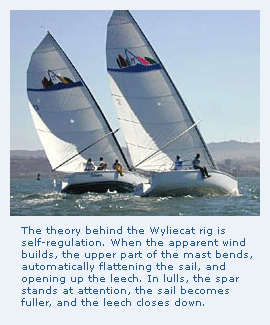by Herb McCormick.
Originally published in Cruising
World
The Wyliecat 30: The more things change, the more they
stay the same.
 In
1935, a Bristol, Rhode Island naval architect named Sidney Herreshoff
(you may recognize the family name) drew the plans for a funky little
number called the AmphiCraft, a 13-foot-1-inch trailerable vessel
that could be fitted with an outboard, rowed, or sailed. For this
discussion, we'll skip the first two options and reach straight
for the halyard. In
1935, a Bristol, Rhode Island naval architect named Sidney Herreshoff
(you may recognize the family name) drew the plans for a funky little
number called the AmphiCraft, a 13-foot-1-inch trailerable vessel
that could be fitted with an outboard, rowed, or sailed. For this
discussion, we'll skip the first two options and reach straight
for the halyard.
For sailing excursions, the plump little daysailer was rigged as
a catboat with a free-standing spar and a wishbone, an arrangement
not unlike the Wyliecat 30, a recent creation from California boatbuilder
Tom Wylie. From this fact the Wylie crew seem to take both pride
and amusement.
When I stepped aboard the Wyliecat 30 last fall on Chesapeake Bay,
I was almost immediately handed a page from on old catalog of Herreshoff
boats featuring the Amphi-Craft. The message, I believe, was this:
"We think we're pretty smart all right, but we know we're not
that smart!"
After a cold, breezy afternoon skittering about the bay on their
quick, simple, maneuverable little sailboat, however, it was pretty
obvious that no one at Wyliecats ever flunked recess. The dudes
from Santa Cruz know how to have a good time.
In fact, it was local guru Bill Lee who coined the expression "fast
is fun". The antecedent to that thought - "Light is right"
- is certainly the philosophy Wylie espoused when fashioning the
rig of his 30-footer. (Wyliecats are also available in 17-, 39-,
and 48- foot versions.) And since the thrust of the boat - literally,
figuratively, and aesthetically - starts with its single-sail power
plant, it's the logical place to begin an Introduction.
For those bent on performance - and it must be underscored that
the exact point of boarding a Wyliecat is to go for a good sail
- carbon fiber is the wave of the present and future. The all-up
weight of the 30's freestanding (no spreaders, shrouds, or attendant
fittings), all-carbon stick is a mere 130 pounds. The wishbone,
with carbon end fittings on 3-inch -diameter aluminum tubes, adds
another 35 pounds, but you get the point: Think quill, as in a feather.
The theory behind the rig is self-regulation. When the apparent
wind builds, the upper part of the mast bends and sways (picture
the tall branches of a willow tree), and pressure is automatically
dumped off the sail. In lulls, the spar stands at attention, the
sail becomes fuller, and the leech closes down. Whatever the breeze,
efficiency reigns.
In practice, you need a puffy day to really test the principle,
and we had a beauty, with 12- to 18-knot winds funneling down the
bay. Downwind, with the fully battened sail eased out like a gate
swung open, we fairly flew down the bay at 6.5 to 7 knots. Upwind,
things were more exciting. Still sailing with a full hoist, it seemed
the boat might've been happier with a reek, as we definitely felt
overpowered in the gusts. Self-regulation is one thing, but a shortened
sail plan further enhances efficient sailing.
The double-ended mainsheet is led aft to the respective port and
starboard coamings of the long, low, open-transomed cockpit for
convenience on either tack. Playing the main is an athletic undertaking
in a breeze. A "choker" line adjusts the wishbone and
is eased or trimmed as the air pressure dictates, in effectacting
as an outhaul, vang, and backstay all in one. lazyjacks bundle the
sail nicely when it's reefed.
The vacuum-bagged hull is a composite laminate around a balsa core,
with carbon-fiber reinforcement at the mast step and the rudderstock
(and. if you opt for one, the diesel auxiliary mounts).
The interior is low and functional, with a couple of double berths
at the ends sandwiching a pair of snug settees and a straightforward
gallery. A trip on a Wyliecat is more akin to camping than opulent
cruising. And if you want to stand up, as the legendary Uffa Fox
once said, go outside. Once there, with the breeze blowing, the
Wyliecat is in its natural element. You don't need to be named Herreshoff
to know what to do next.
|

